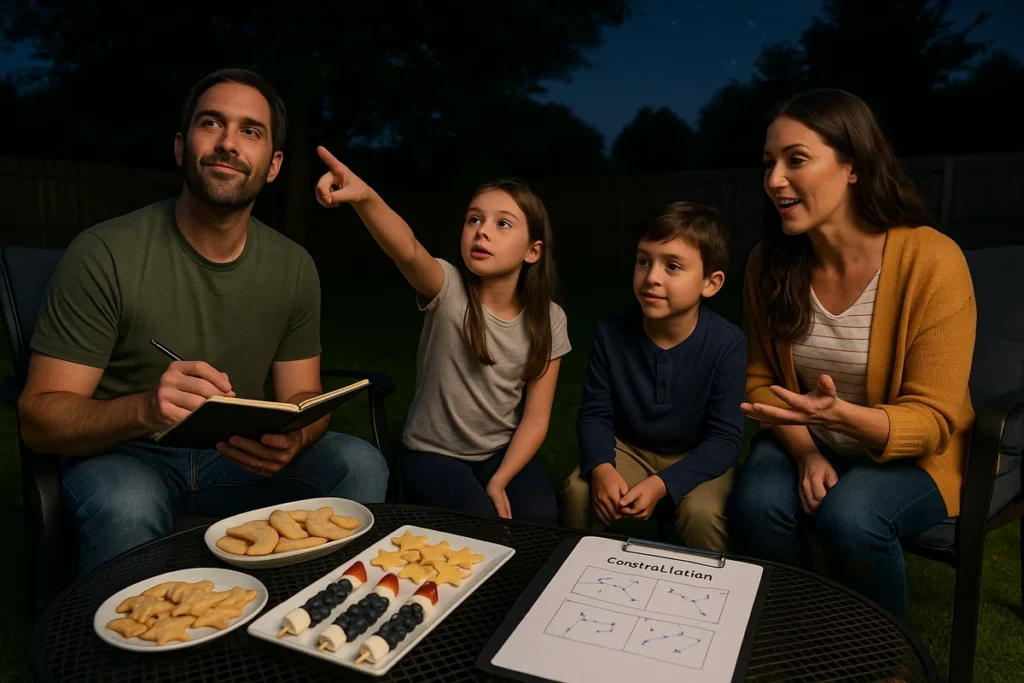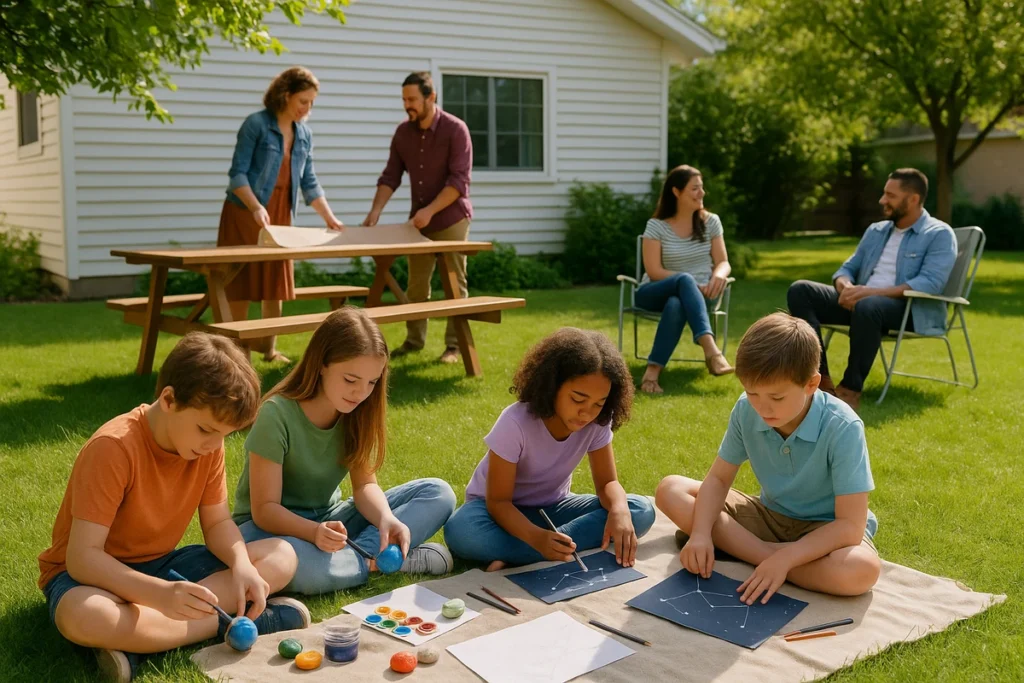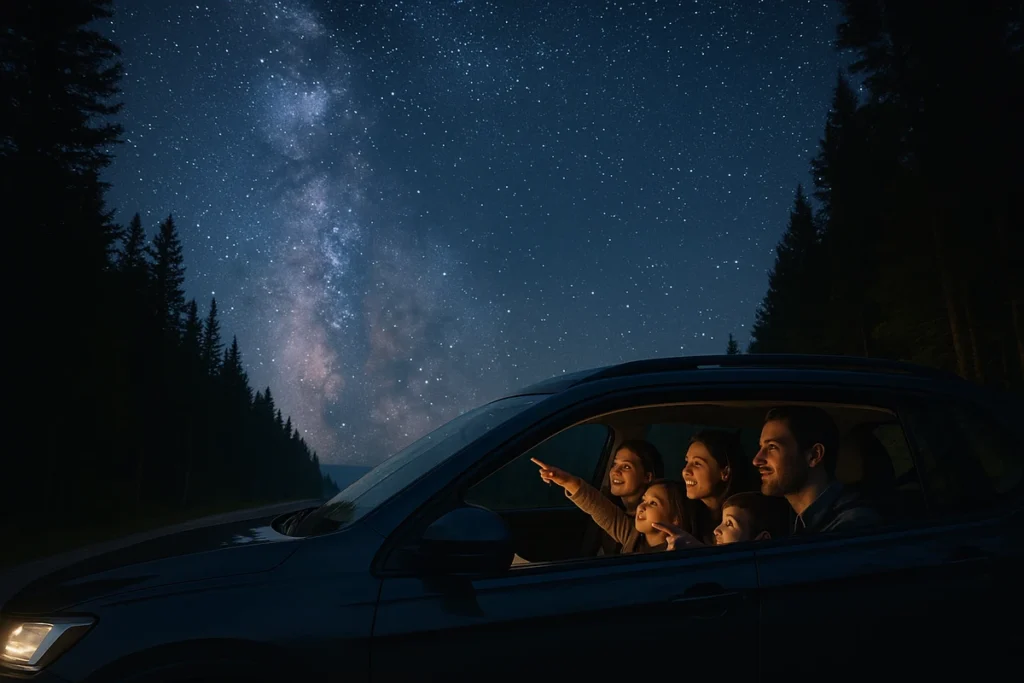Backyard Stargazing Ideas for Families
Your kids probably spend too much time on devices. So do most families. But getting them outside doesn’t mean you have to plan another exhausting day out.
Believe it or not, the night sky above your backyard has all the free entertainment you need to hold their attention. Just grab some lawn chairs, wait for darkness, and let curiosity do the rest.
Backyard stargazing gives your family something to do together without the usual complaints. Even restless kids settle down once they start spotting stars and learning what’s actually out there.
The tips ahead cover simple ways to set up, activities that work for different ages, and how to keep everyone interested beyond the first ten minutes. Let’s jump into it!
Getting Started with Backyard Stargazing
Most parents dismiss the idea and think it takes a lot of time and effort to set up. But the truth is, you’re about five minutes away from your first stargazing session.
Here’s what you need to get started:
Find Your Spot
Walk around your yard after sunset and see where the streetlights aren’t blasting directly overhead. That’s your spot. It’s usually the darkest corner that works best, even if it’s not the most convenient part of your backyard.
Now just toss down some lawn chairs or spread a blanket on the grass. Make sure it’s a cosy blanket, cause you’ll be looking up for a while, and neck cramps end the fun quickly.
Time It Right
Clear nights work better than cloudy ones (groundbreaking insight, I know). But it does help to check when the moon rises. A full moon washes out fainter stars, so aim for nights when it’s less bright or hasn’t come up yet.
From our experience, summer months tend to bring later sunsets, which means the kids can stay up without everyone freezing.
What You’ll Need
You don’t need anything fancy. Your eyes work fine for spotting constellations and planets. Just grab a torch with red cellophane over it so you can see without ruining your night vision.
A star chart app also helps, but you can learn plenty without one. And binoculars beat a cheap telescope any day if you do want to upgrade later.
Activities Beyond Just Looking Up

Staring at the sky is great for about ten minutes. Then the kids start getting restless, and someone needs the toilet. We found that the trick is mixing in other outdoor activities that keep the whole evening interesting.
- Constellation scavenger hunt: Print out a simple star map or use an app to create a list of constellations to find. The little ones love ticking things off as they explore the night sky. Also, the first person to spot Orion’s Belt wins bragging rights. You can even add shooting stars to the list if you’re feeling optimistic.
- Glow-in-the-dark games: Bring out glow sticks or those cheap light-up toys from the dollar shop. And because kids are more likely to sit still after they’ve had a chance to run around, play a quick round of frisbee or tag before settling down.
- Space-themed picnic: Pack some snacks and call it a “moon mission meal.” Gather everyone on blankets with food and decorations if you’re feeling fancy. We can’t explain it, but cheese and crackers taste better under the stars. And no one complains about eating outside when it feels like an event.
- Star stories and mythology: Tell (or make up) the old Greek myths about constellations. Because most of them involve drama, monsters, or both. And once kids’ curiosity kicks in, they realise there’s a proper story behind those dots.
- Night photography attempts: Hand older kids a phone or camera and let them try capturing the stars. Most shots won’t turn out, but they’ll have fun trying. Create a competition for the best image.
While all of these sound fun, we’ll bet that the older kids will get bored faster than the younger ones. That’s is why we’ll cover some ideas for the teens in the sections below.
Ideas for Older Kids
Teenagers and pre-teens need something that feels less like a family activity and more like their own project. Surprisingly, a nature journal works brilliantly for this.
Just hand them a notebook and let them sketch what they see in the night sky. They can draw constellations, track moon phases, or just doodle their thoughts about space. It’s their thing, not yours.
Older kids also love attempting star trails photography with a phone or camera. So, try setting up a tripod (or a stack of books), use a long exposure app, and see what happens. The pictures look impressive even when they’re slightly blurry.
You might notice that some of them are getting interested in identifying deep sky objects when you point them towards apps that show galaxies and nebulae. Once they start creating their own space logs and comparing notes from different nights, you’ve got them hooked.
Daytime Prep for Better Stargazing

Most families overlook the daytime hours before the stargazing session. A bit of prep during the day goes a long way in making the activity more enjoyable for everyone.
Let’s look at a few activities you can plan:
- Paint rocks like planets: Grab some rocks from the garden and let the kids paint them to look like Mars, Jupiter, or whatever they fancy. It gets them thinking about space before the sun even sets. Plus, you can use the painted rocks as decorations around your viewing spot later.
- Collect natural items for space crafts: Send the kids out to gather pine cones, leaves, and twigs. They can turn these into alien creatures or spaceships whilst you’re setting up dinner.
- Create constellation maps together: Print out blank star charts and have everyone colour them in. Older kids can add labels and facts they’ve looked up. And when night arrives, they’ll actually want to find the constellations they spent time drawing.
- Read space books in the garden: Spend twenty minutes outside with picture books about the moon and stars. Even just flipping through the pages gets younger children curious about what they’ll see later.
These small activities turn stargazing from a random idea into something the whole family can prepare for together. A child’s curiosity grows when they’ve had time to think about space throughout the day.
Beyond Your Own Backyard
While your backyard works brilliantly most nights, sometimes a change of scenery adds extra excitement. Like a local park with fewer streetlights often gives you a clearer view of the night sky. Try packing up your blankets and snacks, and make it a mini adventure without the hassle of driving far.

If you’re really keen, look up the nearest dark sky park for a special occasion. The difference is dramatic when you’re away from city lights. You might even spot things that never show up at home, and the Milky Way actually looks like the photos you see online.
During summer, you can mix stargazing with other outdoor activities. For instance, you can ride bikes to your viewing spot whilst there’s still daylight. Or fly kites in the afternoon, then stick around as the sun goes down. Beach trips can work too if you’re near the coast.
The time spent outside builds connection beyond just staring upward. And your kids will remember the whole evening, not just the stars.
Once you experience how nice it is, you might be tempted to make it into a regular thing.
Make Star Gazing a Regular Tradition
The first stargazing session is easy because it’s new. But keeping the excitement alive takes a bit more creativity. So, mix things up so it doesn’t feel like you’re doing the exact same activity every time.
Here are a few things you can try:
- Try a water balloon fight before settling down to watch the sky.
- Plan an evening of fishing if you’ve got a pond nearby, then transition to stargazing as darkness falls.
- Pick flowers and pine cones during the day for craft projects you’ll work on the next afternoon.
These little variations stop the routine from getting stale. And the moment your family starts asking when you’re doing it again, you’ve built something worthwhile.
Some nights you’ll catch a glimpse of the Milky Way. Other nights you’ll just lie there talking. Both count as time well spent, and that’s the whole point, really.
Ready to Start Tonight?
You’ve got everything you need now. We covered finding the right spot in your backyard, timing your sessions for the clearest views, and keeping the kids entertained with activities beyond just staring upward.
The daytime prep ideas help build excitement before the sun even sets. And mixing things up with local park visits or pairing stargazing with other outdoor fun stops from feeling repetitive.
The best part? None of this requires expensive gear or expert knowledge about space. Your family can start tonight if the sky is clear. Grab some blankets, head outside, and see what happens.
For more ideas on getting your family outside and exploring the world around you, check out the Star Hawks Blog. Now stop reading and go see what’s visible tonight!